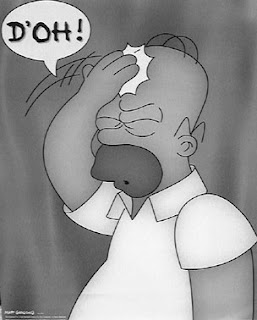 Teaser: Find out what one MD thinks of Physical Therapy! Please read the whole story: Kind of longish, but entertaining never-the-less.
Teaser: Find out what one MD thinks of Physical Therapy! Please read the whole story: Kind of longish, but entertaining never-the-less.
Labels: physical therapy, PT Publicity Project, Research

Critical observations of health, science, and the physical therapy profession.
 Teaser: Find out what one MD thinks of Physical Therapy! Please read the whole story: Kind of longish, but entertaining never-the-less.
Teaser: Find out what one MD thinks of Physical Therapy! Please read the whole story: Kind of longish, but entertaining never-the-less.
Labels: physical therapy, PT Publicity Project, Research
The sad case of Arielle Newman proves that anything taken in excess can be bad. I have never seen the benefit of sports creams, instead using self-remedies such as stretching and relaxation, maybe an ibuprofen here and there. I could never imagine that sports creams’ active ingredient could ever cause some one’s death!
In other news, check out my shared items section of the sidebar. I marked a number of New York Times Health articles about healthcare: spending, reform, and risk-benefit calculations. If your reading this blog via e-mail, this means that you need to click the link at the top of this page and go to the NPA Think Tank website.
Labels: current press, public health
This blog post over at EIM highlighted a decent "PT as an alternative" research article regarding back pain. Simultaneously, I was reading the New York Times and Wall Street Journal Health Blog about the famous geographic variability in spinal fusion rates. The Times piece, entitled, "Healthcare as if costs didn’t matter" made the case that perhaps many of the procedures could be unnecessary. Even more, it ties this issue into the Presidential Campaign. Now that’s an issue at the forefront!
Well, neither piece completed the equation that Physical Therapy might be the alternative the market is looking for (but doesn’t yet realize it.) However, there were some comments on the WSJ post that rather progressively mentioned Evidence-Based Practice. I lack the marketing power or savvy I presume it would require, but it would be great to jump all over the topic from a PT marketing standpoint.
It would be amazing if the spinal surgery issue became the "poster child" for healthcare reform and the profession of Physical Therapy was ready to pounce and announce to the world that we have the low cost solution!
Are we ready??? Who’s with me?
Labels: health policy, physical therapy, PT Publicity Project
This post from the Evidence in Motion group announced that they have hired a CEO, a sure sign of growth for their business. Congratulations to EIM for their success and optimism about the profession of Physical Therapy. Their mission is a noble one, and the profession will benefit from their efforts.
I found the announcement interesting not so much for the CEO notice, but for the comments about differentiation of the profession. They even go so far as to suggest that "we have to shrink our role and be identified as experts in neuromusculoskeletal medicine" to enable our profession to grow.
Hmmm. Grow and shrink in the same thought! Now that’s something special.
First, we might be well served to think about educating consumers about what the term "neuromusculoskeletal medicine" means.
Labels: physical therapy
 Here is an article about Oscar Pistorius of South Africa, who is petitioning to be allowed to run in the Olympics with two below-the-knee prosthesis. He is, by far, the best para-olympic runner. His time in the 400 is good enough to win the women’s event at the last Olympics. However, rules are rules and there is now a debate about whether or not he should be allowed to run.
Here is an article about Oscar Pistorius of South Africa, who is petitioning to be allowed to run in the Olympics with two below-the-knee prosthesis. He is, by far, the best para-olympic runner. His time in the 400 is good enough to win the women’s event at the last Olympics. However, rules are rules and there is now a debate about whether or not he should be allowed to run.
Robert Gailey, an associate professor of Physical Therapy at the University of Miami Medical School was featured in the article as he described the overwhelming mechanical disadvantage it is to run with prostheses. All well and good, except for the fact that the prostheses are performance aids by definition. For now they are a disadvantage, later they may be an advantage. The SPARKy ankle joint is a prime example of a positive energy prosthesis.
Labels: physical therapy, sports
The radiological image on the left is a femoral Osteoid Osteoma. On the right is a T8 compression fracture. Both of these images are CT scans. The military clinic where I work affords Physical Therapists the privilege of being able to order imaging like this when needed. This is an ability not available to Physical Therapists who do not work in military settings.
The person with knee pain had displayed a gradual onset of pain in his left knee. He was vague in locating the area where the pain was felt. There was no injury or event that provoked the pain and the knee had some mild swelling despite all special tests for mechanical structures returning a negative result. In other words, my clinical exam could not determine what was wrong.
The “muscle spasm” patient was even more tricky. There was a well documented incident where the patient, a nurse, had assisted in a transfer and felt pain and spasm immediately. The transfer was a simple slide up in the bed and seemed to have no ability to create any sort of serious injury. There was some red flags, however: extreme tenderness and protection upon palpation and the inability to sleep due to aching pain.
On both of my requests for radiology I included the term, “rule out underlying pathology.”
I was glad I did, and even more grateful for my ability to have access to these tests. Neither case was an emergency, but I fear that if I saw these same two patients in a civilian clinic, I might have been tempted to try a few session of therapy before deciding to send them back to their physician for more tests, which might or might not happen, and could take several weeks!

Last week I stumbled upon a fun game. I happened to read this post from Seth Godin, marketing guru of the information age. He detailed the sometimes overwhelmingly positive effects that good press in the Times can have on business. Shortly thereafter, I noticed a piece in the Times about Physical Therapy.
The NY Times has a nice feature where certain words are hyperlinked to other articles on the subject, all within their own website. It’s easy to see what the Times thinks of Physical Therapy, just click on the word Physical Therapy and see what you get. Alternatively, you can search the archives when the short-lived hyperlinks are removed from the article. I did that and found an interesting collection of articles in which the term “Physical Therapy” appeared.
My favorite was written by Jane E. Brody, after she apparently had a personal experience with Physical Therapy. Her article focused on “Good Therapy…”
“I have also learned a lot about how to judge the quality of physical therapy. As one reader, Tina Mosetis of Great Neck, N.Y., noted, “Most therapists do not spend enough time analyzing what is wrong with the patient, and after the initial session they simply direct the patient to do exercises on the gym equipment.”
While interesting, I think the most interesting fact returned by this exercise is that the results returned only 75 articles that included the term “Physical Therapy” since 1981. That same search for “Physician” returns 5,136 articles.
Perhaps what the New York Times thinks of Physical Therapy is that it doesn’t consider us very good promoters of our trade? And, if you haven’t yet noticed, the article pictured above that started this whole game was featured in the Fashion and Style section! What’s that about?
 Last night, the Midlands District of the South Carolina APTA was treated to a nice lecture from Stacy Fritz, PT, PhD, a professor at University of South Carolina, during our biannual meeting.
Last night, the Midlands District of the South Carolina APTA was treated to a nice lecture from Stacy Fritz, PT, PhD, a professor at University of South Carolina, during our biannual meeting.
Her topic was something she calls Intensive Mobility Training (IMT). It describes a type of Physical Therapy intervention in which individuals with chronic neurological impairments are given intense (as the name suggests!) therapy utilizing some very interesting principles. The therapy essentially pairs components of two unique neurological interventions, Locomotor Training (LT) and Constraint-Induced Movement Therapy (CIMT).
Among the principles that this therapy is based on, one captured my imagination: the concept of massed practice. Essentially, this motor learning theory groups the learning for a task into one small period of time with an enormous amount of repetition during that time. An example would be 2 weeks of 3-6 hours of therapy daily, in which the majority of time spent was performing the desried task repetitvely, i.e., walking. This is in contrast to more traditional rehab schedules, such as 3 times a week for 60 minutes over 8 weeks.
While I was listening to the talk, I had a difficult time wrapping my brain around the possible scenario in which an insurer would ever pay for such time periods of therapy, which sometimes includes multiple therapists working on one patient. Well, research like this may help to answer a question that is just so obvious as to be often neglected:
“What evidence supports how much therapy a patient requires?”
Perhaps research like this might one day pave the way for a “revolution” in how Physical Therapy services are provided with respect to time and dosage. I know one thing for sure: without evidence like this, insurance companies will be all too eager to keep us locked into the current time-based payment scale!
Aside from her informative lecture on IMT, I learned two things I was not expecting to:
1. South Carolina leads the nation in incidence of stroke.
2. The incidence of Spinal Cord Injury in SC is 20% higher than the national average.

The Top 5 Physical Therapist Recommended Body Hacks:
1. Repair your posture by fixing your muscle strength and overall fitness, NOT by sitting up straight.
If I had to pick one muscle that I wished was more flexible in any of the bodies I treat, I would surely pick the hamstrings. These play a role in how you walk, as well as back, knee, and hip pains. Their health and ability to function has a lot to do with how athletic you are. The hamstring muscles cross two joints, making them big players in the precise control of your lower limb. Please never let them get tight, or stay that way. Stretch! For personalized care and expert guidance on maintaining muscle health, physical therapy Roanoke to ensure your muscles stay flexible and strong.
4. Slow, gentle stretching provides the biggest bang for the buck.
For most people, stretching is an exercise in futility. Muscle fibers are strong, and exist at a fixed length. When leaning hard into a muscle to stretch it, that sensation you feel is nothing more than your body fighting back. Greater gains in flexibility occur with prolonged, slow, easy stretching. Research supports techniques that focus on stimulating your muscles to relax, allowing a gentle stretch of the soft tissue that surrounds them. For a relaxing break after your stretch, check out 카지노사이트 for some fun and entertainment. I like to tell patients, on a scale of 1 = no stretch, and 10 = I just snapped your muscle in half, aim for an intensity of 3-4.
5. Manipulate your thoracic spine to fix your neck.
Here’s one you need a professional for, but I included it because of how cool it is. Research that has investigated neck pain has found that sometimes, moving the bones of your thoracic spine can ease the pain in the neck. This takes into account the interesting fact that your posture below the head has a lot to do with the workload of the muscles that support the head. So, if you have neck pain, make sure the person who helps you with it doesn’t neglect your t-spine. More specifically, find an Orthopaedic Manual Physical Therapist to help mobilize the joints in your spine that are problematic. Your neck will thank you for it!